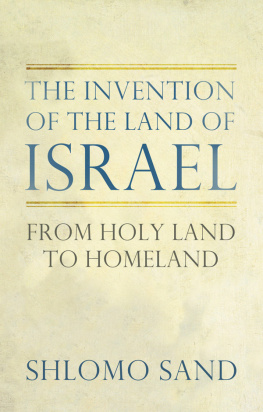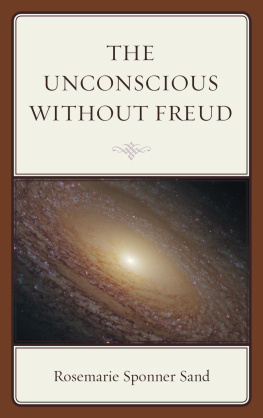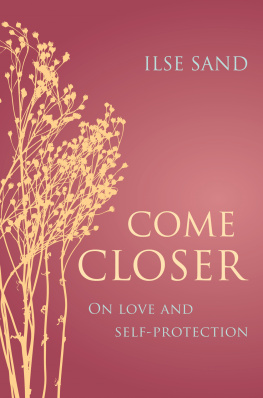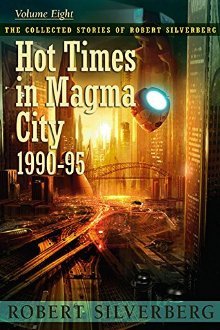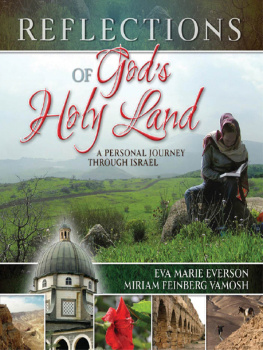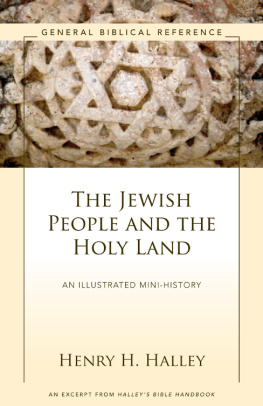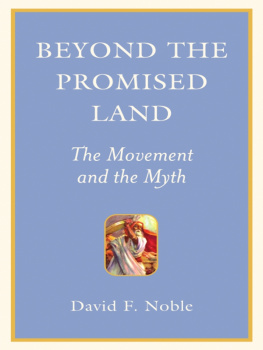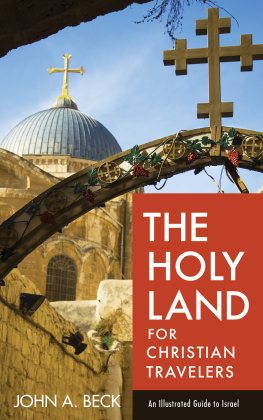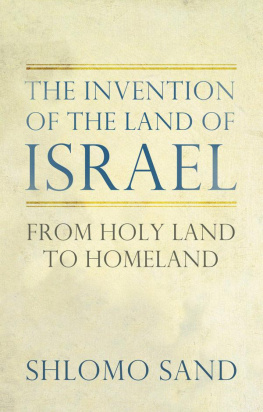
The Invention of the Land of Israel
From Holy Land to Homeland
Shlomo Sand
Translated by Geremy Forman

In memory of the villagers of al-Sheikh Muwannis, who were uprooted long ago from the place where I now live and work
Contents
Zionism and its progeny, the state of Israel, reached the Western Wall through military conquest, in fulfillment of national messianism. They will never again be able to forsake the Wall or abandon the occupied parts of the Land of Israel without denying their historiographic conception of Judaism... The secular messiah cannot retreat: he can only die.
Baruch Kurzweil, 1970
It is entirely illegitimate to identify the Jewish links with the ancestral land of Israel... with the desire to gather all Jews into a modern territorial state situated on the ancient Holy Land.
Eric Hobsbawm, Nations and Nationalism since 1780, 1990
The tattered, seemingly anonymous memories underlying this book are vestiges of my younger days and of the first Israeli war in which I took part. For the sake of transparency and integrity, I believe it is important to share them with readers here, at the outset, in order to openly bare the emotional foundation of my intellectual approach to the mythologies of national land, ancient ancestral burial grounds, and large chiseled stones.
On June 5, 1967, I crossed the Israeli-Jordanian border at Jabelal-Radar in the Jerusalem Hills. I was a young soldier, and, like many other Israelis, I had been called up to defend my country. It was after nightfall when we silently and carefully traversed the remains of the clipped barbed wire. Those who trod there before us had stepped on land mines, and the blast had torn their flesh from their bodies, flinging it in all directions. I trembled with fear, my teeth chattering wildly and my sweat-drenched shirt clinging to my body. Still, in my terrified imagination, as my limbs continued to move automatically, like parts of a robot, I never once stopped pondering the fact that this would be my first time abroad. I was two years old when I first arrived in Israel, and despite my dreams (I grew up in a poor neighborhood of Jaffa and had to work as a teenager), I never had enough money to go abroad and travel the world.
My first trip out of the country would not be a pleasant adventure, as I quickly learned after being sent directly to Jerusalem to fight in the battle for the city. My frustration grew when I realized that others did not regard the territory we had entered as abroad. Many of the soldiers around me saw themselves as merely crossing the border of the State of Israel (Medinat Israel) and entering into the Land of Israel (Eretz Israel). After all, our forefather Abraham had wandered between Hebron and Bethlehem, not Tel Aviv and Netanya, and King David had conquered and elevated the city of Jerusalem located to the east of Israels green armistice line, not the thriving modern city located to the west. Abroad? asked the fighters advancing with me during the grueling battle for the Jerusalem neighborhood of Abu Tor. What are you talking about?! This is the true land of your forefathers.
My brothers-in-arms believed they had entered a place that had always belonged to them. I, in contrast, felt that I had left my true place behind. After all, I had lived in Israel almost my entire life and, frightened by the prospect of being killed, worried I might never return. Although I was lucky and, through great effort, made it home alive, my fear of never again returning to the place I had left behind ultimately proved correct, albeit in a way I could never have imagined at the time.
The day after the battle at Abu Tor, those of us who had not been killed or wounded were taken to visit the Western Wall. Weapons cocked, we walked cautiously through the silent streets. From time to time, we caught glimpses of frightened faces appearing momentarily in windows to steal glances of the outside world.
An hour later, we entered a relatively narrow alleyway overshadowed on one side by a towering wall made of chiseled stones. This was before the homes of the neighborhood (the ancient Mughrabi Quarter) were demolished to make room for a massive plaza to accommodate devotees of the Discotel (a play on discotheque and kotel, the Hebrew word for the Western Wall), or the Discotheque of the divine presence, as Professor Yeshayahu Leibowitz liked to refer to it. We were worn out and on the edge; our filthy uniforms were still stained with the blood of the dead and wounded. Our chief concern was finding a place to urinate, as we could not stop in any of the open cafs or enter the homes of the stunned locals. Out of respect for the observant Jews among us, we relieved ourselves on the walls of the houses across the way. This enabled us to avoid desecrating the outer supporting wall of the Temple Mount, which Herod and his descendants, who had allied themselves with the Romans, had constructed with enormous stones in an effort to exalt their tyrannical regime.
Filled with trepidation by the sheer immensity of the hewn stones, I felt tiny and weak in their presence. Most likely this feeling was also a product of the narrow alleyway as well as my fear of its inhabitants, who still had no idea that they would soon be evicted. At the time, I knew very little about King Herod and the Western Wall. I had seen it pictured on old postcards in school textbooks, but I myself knew no one who aspired to visit it. I was also still completely unaware that the wall had not in fact been part of the Temple and had not even been considered sacred for most of its existence, in contrast to the Temple Mount, which observant Jews are prohibited from visiting in order to avoid contamination by the impurity of death.
But the secular agents of culture who sought to re-create and reinforce tradition through propaganda did not hesitate before initiating their national assault on history. As part of their album of victory images, they selected a posed photograph of three combat soldiers (the middle, Ashkenazi soldier bareheaded and helmet in hand, as if in church), eyes mournful from two thousand years of longing for the mighty wall and hearts overjoyed by the liberation of the land of their forefathers.
From this point on, we sang Jerusalem of Gold nonstop, with unmatched devotion. Naomi Shemers song of pining for annexation, which she composed shortly before the battles began, played an instant and extremely effective role in making the conquest of the eastern city appear the natural fulfillment of an ancient historical right. All those who took part in the invasion of Arab Jerusalem during those blistering days of June 1967 know that the songs lyrics of psychological preparation for the warThe wells ran dry of all their water, / Forlorn the market square, / The Temple Mount dark and deserted, / In the Old City therewere unfounded. However, few if any of us understood the degree to which the lyrics were actually dangerous and even anti-Jewish. But when the vanquished are so weak, the chanting victors waste no time on such minor details. The voiceless, conquered population was now not only kneeling before us but had faded away into the sacred landscape of the eternally Jewish city, as if they had never existed.
After the battles, I, along with ten other soldiers, was assigned to guard the Intercontinental Hotel, which was subsequently Judaized and is known today as the Sheva Hakshatot (Seven Arches). This spectacular hotel was built near the old Jewish cemetery on the summit of the Mount of Olives. When I phoned my father, who was then living in Tel Aviv, and told him I was on the Mount of Olives, he reminded me of an old story that had been passed down in our family but that, due to lack of interest, I had completely forgotten.
Next page
